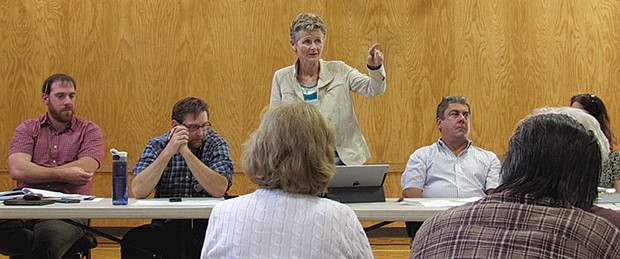Fast and Reckless
Community members off Highway 36 bemoan rapid growth of cannabis industry
By Linda Stansberry [email protected] @lcstansberry[
{
"name": "Top Stories Video Pair",
"insertPoint": "7",
"component": "17087298",
"parentWrapperClass": "fdn-ads-inline-content-block",
"requiredCountToDisplay": "1"
}
]
Every folding chair in the Bridgeville school gym was pressed into use on June 30, as the room filled with more than 100 community members. They came from neighboring communities, from Dinsmore and Hydesville and Mad River and all points in between. Mothers nursing babies, senior citizens with perfectly coiffed hair, sunburned young men with T-shirts tucked into jeans, they came to stare down 10 officials from the public agencies directly related to the county's recent medical marijuana and land use ordinances, and to ask the question that, over the course of three hours, no one seemed to answer with any clarity: What is going to happen to our community?
"We feel like since they passed the ordinance, the whole world is here trying to make a big buck. They don't care about the land or the community," said Pam Walker, who organized the community meeting and led the opening remarks. Walker was one of several people from the Bridgeville and Larabee Valley area who went to Humboldt County 2nd District Supervisor Estelle Fennell's office last month to voice concerns about an increased number of commercial grows and associated water overuse, illegal grading, dangerous driving and public safety issues.
Fennell, who facilitated the meeting, invited representatives from the North Coast Regional Water Quality Board, Humboldt County Sheriff's Office, California Highway Patrol, California Department of Fish and Wildlife and the Humboldt County Planning and Building Department to answer questions and address community concerns. Bridgeville and its neighboring hamlets are at least an hour away from the nearest hospital, far away from the seat of county government, and rely on a patchwork of homespun volunteer organizations, such as the community center, volunteer fire departments and Southern Trinity Ambulance Rescue to augment a dearth of official resources. For decades the community, accessible only by the narrow and winding State Route 36, with its western borders bottlenecked by a state park, has been largely self-reliant and insular. But its very remoteness, combined with recent changes in the state and county medical marijuana laws, has made it a popular place for outsiders hoping to strike it rich in the "green rush." They're not pioneers; cultivation is woven into the fabric of the local culture. But the new arrivals, Walker and others argue, unfairly tax both the social and environmental resources of the community, while giving little to nothing back. And the county, whose land use ordinance they allege enticed these growers into the area, is providing little in the way of oversight or protection.
Water usage was at the top of an ambitious agenda. Many people in the area rely on wells, which they use sparingly in the summer to accommodate neighboring homesteaders who share the same water table. The aquifers and streams are inadequate to support commercial agriculture. But, of course, that's now exactly what they're being used for: Under new county medical marijuana laws, permitted grows are not allowed to truck in water from an outside source. New wells are being dug, and many people complain that their own wells, creeks and springs are running dry far ahead of schedule. Who, they asked the representatives, is regulating this?
"Nobody," said Scott Bauer, a biologist with the CDFW, referring to the question of groundwater. Rob Wall, interim county planning director, added that California is one of the last states in the nation to regulate groundwater. As for creeks and streams, violations can be reported to the state water control board or other entities for investigation.
Well, asked community members, can they report trucks stacked with fertilizer or water tanks speeding around the turns? Yes, came the reply, but carrying soil or water is not illegal in and of itself. And the sheriff and CHP are both understaffed, largely, they said, due to a lack of qualified candidates. A new resident deputy assigned to the area, Benjamin Filippini, is due to start in October. He recently graduated from the College of the Redwoods Police Academy.
"Where will you be stationed?" asked one older woman.
"Hydesville, ma'am," he replied.
"Hydesville! It will take you 40 minutes to get anywhere."
"20 minutes, ma'am."
"Well, then you're flying, young man," she said, to a round of laughter.
There was a general sense of disconnect between the crowd and the public officials around the issue of permitting. Senior County Planner Steve Lazar repeated several times that it would take some time for the industry to transition into legality and, once the tax revenue kicks in, there will be more money available for enforcement.
"We're waiting for the cannabis community to move forward and get licensed. This is a community of folks who are not prepared to flip the switch," said Lazar, asking for patience.
The crowd seemed less than receptive to this idea. With the Aug. 31 deadline for registration approaching, the county says 308 grows have registered, with 34 in the Van Duzen watershed. But many growers are moving forward without approved permits, and still more are operating without any kind of permit whatsoever, as they have for decades. Fennell said unregulated growth has perpetuated a sense of lawlessness that will soon come to an end.
"You're not going to get by with pulling the wool over our eyes," she said. "Eventually, we're going to get you."
There was some muttering at this statement. While many of the representative agencies repeatedly asked residents to report issues, with the sheriff's office insisting its response was "complaint driven," many are reluctant to do so. An anonymous complaint is never anonymous, they implied, in a place where everyone knows his or her neighbors. (Many of those in the audience did not want their names or photos used in this article.) One woman, balancing her toddler on her hip, said she called the sheriff's office several times when neighbors threatened her young family with violence.
"They clearcut 5 acres that weren't theirs, are growing in the creekbed, have no water, their pitbulls are attacking my livestock, and I worry about them attacking my children," she said.
"We're complaint driven. Call us, let us know," came the reply.
"I have been calling, nobody's doing anything," she said, to a flurry of nods.
Later her partner, an Iraq War veteran, stood and also addressed the officers. He alleged that the same neighbors, four men, attacked and beat him during a confrontation about water use. Officers met him at the hospital but did not take steps to protect him or his family, or enforce an existing restraining order, he alleged. (The HCSO confirmed this incident is under investigation.)
"I stuck my neck out for this country," said the young man. "I deserve to be protected too."
His words were met with a round of applause.
"My son is going to bed with a plastic sword every night," he went on, adding that the neighbors had also threatened to hurt their children. "I don't have the ability to keep my family safe. I'm losing faith that this will go anywhere."
As the meeting wore on into the late afternoon, a theme developed. The agencies asked for better communication, and the community members asked for better representation. With a complex tangle of various regulatory agencies governing unincorporated areas, complaints were often volleyed from one bureau to another. Sheriff Mike Downey encouraged people to show up to planning department meetings. Lazar said until permitting was standardized and had funded enforcement, complaints would have to go to the sheriff's office. Ultimately, many of the issues fall into the empty spaces once governed by simple human kindness and a sense of community. With only four CHP officers to cover all of Humboldt County at any given hour, for example, what are the chances that one will be available to arrest the reckless drivers crossing the highway's double yellow line to pass the school bus, as its driver Tim Smith said has happened "countless times" in the last year? The bus has been run off the road at least once, with Smith forced to slam on the brakes to avoid an accident. Law enforcement officers have encouraged him to call in license plates and, since Smith has to keep his eyes on the road, he has recruited the terrified children to keep track of the numbers for him. Next year, due to budget cuts, the tiny school may not have a bus at all. Its enrollment numbers have been steadily dropping due to safety concerns and families being priced out of the area. One mother said she routinely leaves her child at home rather than drive with her in the car, and it chafes to see "million dollar trucks" roaring down the road when community institutions are struggling to stay afloat.
At the close of the meeting, Fennell thanked the community for opening the dialogue.
"Some of these issues are very, very tough," she said. "I'm glad to be able to have that conversation."
Reached by phone the next day, Walker said that although many questions remain unanswered, she was "very, very proud" of her community for showing up and speaking out.
Comments (2)
Showing 1-2 of 2
more from the author
-
Lobster Girl Finds the Beat
- Nov 9, 2023
-
Tales from the CryptTok
- Oct 26, 2023
- More »
Latest in News
Readers also liked…
-
Through Mark Larson's Lens
A local photographer's favorite images of 2022 in Humboldt
- Jan 5, 2023
-
'To Celebrate Our Sovereignty'
Yurok Tribe to host gathering honoring 'ultimate river warrior' on the anniversary of the U.S. Supreme Court ruling that changed everything
- Jun 8, 2023



































